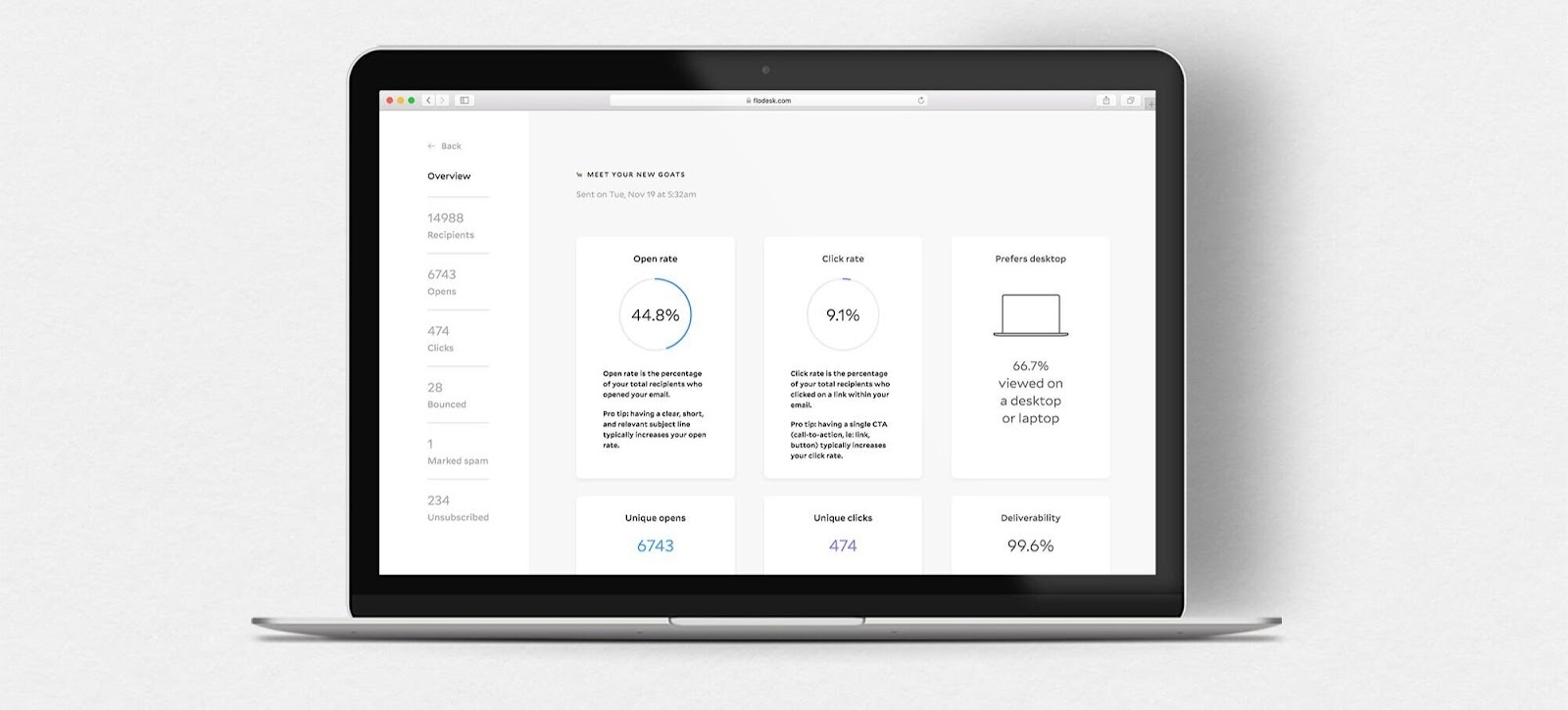How to calculate email subscriber value in 5 easy steps
Table of Contents Jump to:
Jump to:
Table of contents
Because email marketing typically has a good return-on-investment (ROI), many teams don’t bother to investigate exactly how profitable their strategy is overall. They spend precious time and resources building their subscriber lists, integrating the latest email marketing trends, and sending out stunning email marketing campaigns, but don’t actually know how much revenue the average subscriber brings into their business.
Well, that disconnect stops now. Calculating email subscriber value is a great way to understand the kind of income your contacts are generating for your company alongside other important insights like lifetime value and specific marketing campaign ROI.
Let’s explore what email subscriber value is, how to calculate it, and some best practices to implement when you’re figuring it out.
Get unlimited email sends & subscribers with Flodesk
We’ll never increase pricing because your email list is growing
What is email subscriber value?
Email subscriber value (SV), also known as marketing allowable or revenue per subscriber (RPS), tells you how much income your email marketing contacts bring your business.
It’s a valuable metric that’s relatively easy to calculate, and it can inform everything from what individual subscribers are “worth” to how much time and effort you should invest into acquiring new leads and growing your email list.
How to calculate email subscriber value
Calculating your email subscriber value is pretty straightforward. If you want to know how much income your contacts are producing for your business on average, take the following steps:
1. Determine your active subscriber count
To calculate your email subscriber value accurately, figure out how many active subscribers you have. Active is the key word here, because inactive subscribers don’t bring any income into your business or carry any value. For that reason, it’s a good idea to do some basic email list management before you start figuring out the average value of your subscriber list.
As a basic rule, if any of your subscribers haven’t opened and/or clicked on any of your email marketing content over the past six months, they’re an inactive contact.
So, you might have 10,068 email subscribers, but only 9,700 active email subscribers you should use to calculate subscriber value.
2. Figure out how many direct sales you made from email marketing
This step is one of the most difficult parts of calculating email subscriber value because it’s not always easy to attribute sales to a certain marketing strategy. Depending how far you want to get into the nitty-gritty details, you may have to hold multi-department meetings to figure out what percentage of your company’s yearly sales came from email marketing.
However, the following kinds of sales are usually easy to attribute to email marketing:
- Sales made after a subscriber clicked on a direct link in an email
- Sales made with a discount code provided in an email
And these kinds of sales are more difficult:
- Social media sales
- Organic search sales
- Brick-and-mortar shop purchases
Email marketing software for ecommerce often estimates how much revenue individual marketing emails produce, but this data doesn’t always tell the full story. You’ll likely need to do your own research on top of those metrics.
Once you’ve spent some time on this step, you’ll eventually come up with a rough number of how much income resulted from your email marketing strategy during a specific time period. Some marketers choose to then calculate newsletter cost and subtract that from their gross income to get a more accurate “net” picture of average email subscriber value.
3. Choose a specific time frame
To get an email subscriber value that’s relevant to your business needs and email marketing goals, you’ll need to work with a specific time frame in your calculations.
Some of the most common examples include:
- Monthly email subscriber value
- Annual email subscriber value
- Lifetime email subscriber value
4. Make your calculations
Now that you’ve figured out how many active subscribers you have, how much income you made from email marketing sales, and the time period you’re working with, you’re ready to calculate your email subscriber value.
There are a few different ways to determine email subscriber value, but let’s work with the most straightforward method for this example. Say your company wants to determine annual email subscriber value to inform your ecommerce email marketing budget for the upcoming fiscal year.
You have:
- 13,020 active email subscribers (X)
- $205,469 in annual sales from email marketing (Y)
When you divide Y by X, you get: $15.78 as your annual email subscriber value.
5. Analyze your email subscriber value and determine what that means for your business
Figuring out email subscriber value is only useful if you consider your findings and put them into action to make more strategic business decisions and drive long-term marketing success.
Here are just a few of the ways you can analyze email subscriber value to optimize your approach to email marketing:
- Overall list building efforts: Email subscriber value helps businesses understand whether they’re spending too much, too little, or just the right amount of resources building their subscriber list. For instance, if you know you spend an average of $5 acquiring a new lead but they have an average monthly value of $25, that’s a worthwhile investment.
- Customer lifetime value: Customer lifetime value is how much revenue customers are bringing in throughout their entire relationship with your business, from first to most recent purchase. Once you’ve figured out annual email subscriber value, you can easily calculate customer lifetime value, which you can use to figure out how profitable your loyal customers are vs. new leads.
- ROI on specific marketing campaigns: Understanding email subscriber value can help you determine how much you’d have to make from marketing campaigns for them to be worthwhile. For example, if you spent $5,000 on an email marketing campaign but know your contacts generate the same or more than that amount per month in sales, you’re in a good position.
Get unlimited email sends & subscribers with Flodesk
We’ll never increase pricing because your email list is growing
Best practices for measuring subscriber value
Now that you know how to calculate email subscriber value, keep the following tips and best practices in mind to make sure your calculations are helpful, accurate, and can actually help move your business forward.
Select your email subscriber value time frame wisely
As we mentioned above, you can choose to work with lots of different time frames when you’re figuring out average email marketing subscriber value.
To determine the best time period for your calculations, get clear on why you want to figure out average subscriber value in the first place.
Here are some examples of how that looks in practice:
- Monthly: If you have the team size and resources, many email marketing professionals like calculating monthly email subscriber value. Monthly value gives you enough data to make well-informed decisions while keeping quantities manageable and timing flexible enough to pivot between different marketing strategies.
- Annually: Some email marketing teams find annual email subscriber value helpful if they want to decide on yearly marketing budgets or determine how to best allocate their marketing resources.
- Customer lifetime: Calculating the customer lifetime value of an email subscriber produces “big picture” data. That means it’s ideal if you want to understand general trends related to lead acquisition and subscriber retention or are planning to sell your business in the near future.
Keep an eye on other handy email marketing metrics
While email subscriber value is a great metric for businesses of all sizes to monitor, it’s not the be-all-end-all. In fact, email subscriber value is most insightful if you analyze it alongside other helpful ecommerce email marketing metrics, and here are some of our favorites:
- Conversion rate
- Open rate
- Cost per lead or cost per qualified lead
- Click-through rate
- Click-to-open rate
- Bounces, unsubscribers & complaints
- Overall return-on-investment (ROI)
- List growth over time
Read Next: Email Opt-In Best Practices
Try different ways of calculating email marketing subscriber value
We’ve covered one of the easiest and most straightforward ways to determine email marketing subscriber value in this article, but there are several different approaches you can take. Depending on your situation, another method might be more appropriate.
Here’s an example:
- Subscriber value for a specific email marketing campaign:
- Revenue generated from the specific email marketing campaign (X) divided by the number of email subscribers you sent your campaign to (Y)
- For example: $26,046 (X) /5,760 (Y)= $4.52
Bring value to your subscribers with beautiful emails
All in all, calculating average email subscriber value should be an integral part of any savvy marketing team’s strategy. It doesn’t just tell you how much money individual email marketing contacts bring into your business—it can also assist you in choosing your ideal types of subscription forms and optimizing your overall email marketing strategy, deciding where to allocate your marketing budget, informing lead acquisition and customer retention, and helping you create more impactful marketing campaigns.
Perhaps more important of all, one of the best things you can do to continually attract new subscribers and retain loyal customers is consistently sending out professional, engaging, stunning email newsletters with a top-of-the-line email service provider like Flodesk. We’ve even got a lengthy 30-day free trial so you can assess our platform for yourself, no strings attached.
FAQs about email subscriber value
How is email subscriber value calculated?
You can calculate email subscriber value, also known as marketing allowable or revenue per subscriber (RPS), by dividing the direct sales you made via email marketing within a specific time period by your number of active subscribers.
For example, if your business made $100,000 in direct sales with the help of email marketing in a year and had 10,000 active subscribers, your annual email subscriber value (SV) would be $10.
With that data, you can also calculate total lifetime email subscriber value.
How do email lists make money?
The biggest way email lists make money is by driving traffic to websites, landing pages, product pages, or online shops and boosting sales. However, there are lots of other ways email marketing can make money, including:
- Paid subscription models
- Selling advertisement space
- Cross-promotions
- Email sponsorships
- Affiliate marketing
- Webinars and other online events
- Online coaching and consulting
Using a premium email marketing software like Flodesk makes it easy to monetize your subscriber list — sign up for a free trial!
What is the value of an email list?
It can be difficult to determine the overall value of your email list, but one easy way to figure it out is by calculating your annual email subscriber value.
That data will tell you how much income each of your email marketing contacts brings you throughout a specific time period on average. You can also use that information to figure out total lifetime email subscriber value.



